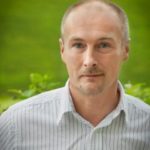
Date: April 19, 2018
Time: 12:30 p.m. - 1:30 p.m.
Location: Maeder Hall
Paul Langan, of the Oak Ridge National Laboratory, will speak on the role of “Neutron Sources for Energy and Environmental Research” as part of the 2017/2018 Highlight Seminar Series at the Andlinger Center for Energy and the Environment at Princeton University.
ABSTRACT
Our vision for neutron sources at Oak Ridge National Laboratory (ORNL) is to be the place where transformative scientific breakthroughs are made. We focus on enabling scientific discoveries and solving critical scientific challenges that can be best addressed using the unique information provided by neutron scattering and that can leverage the integrated core capabilities and expertise found across ORNL. To achieve this vision, we operate and develop the Spallation Neutron Source (SNS) and the High Flux Isotope Reactor (HFIR) as advanced neutron scattering user facilities and we look for collaborative partnerships that enable innovation and scientific excellence. Each year, over a thousand visiting researchers from academia, industry, ORNL and other Institutes collaborate with us to use the SNS and HFIR for research over a broad range of disciplines. Some areas of neutron scattering research, such as new materials, solar energy and thermoelectricity, energy storage, superconductivity and quantum materials, carbon capture and gas storage, catalysis, complex biological systems, bioproducts and photosynthesis are relevant to critical challenges in energy and environmental research. In this talk, I will give examples of recent results and discuss future opportunities for the application of neutron scattering in energy and environmental research.
BIO
Paul Langan began his tenure as the Associate Laboratory Director (ALD) for the Neutron Sciences Directorate (NScD) at the Oak Ridge National Laboratory (ORNL) on January 1, 2015. As ALD, Langan overseas the operation and management of two neutron facilities: the Spallation Neutron Source (SNS) and the High Flux Isotope Reactor. Each year, these facilities support about 3000 visiting users. He aims to further broaden ORNL’s role in neutron sciences globally, expand ORNL’s instrument capabilities, and prepare for a second target station at SNS.
Langan most recently was the Director of the Biology and Soft Matter Division in NScD at ORNL and a prestige research professor in the department of Chemistry of Toledo University. He is Director of the U.S. Department of Energy (DOE) funded Center for Structural Molecular Biology (CSMB) at ORNL, he led a National Institute of Health (NIH) funded consortium that develops computational tools for neutron crystallography, and he has been involved in leading various ORNL and Los Alamos National Laboratory (LANL) Laboratory Directed Research and Development (LDRD) funded projects over the years. In particular, he has led efforts to develop drugs against cancer and AIDS, to re-engineer enzymes, and to revolutionize the efficiency of cellulosic biomass conversion to fuels and other products. He is past director of the DOE funded Protein Crystallography Station (PCS) at LANSCE and LANL lead for a University of California (OP) funded program led by University of California San Diego on the cellular function of protein kinases. He is co-principal investigator for several DOE and NIH funded grants that are based on applying the techniques of imaging and crystallography. Other positions include the editorial board of the journal Cellulose, co-Editor for Acta Crystallographica Section D, chairman of the Neutron Scattering Commission of the International Union of Crystallography (IUCr), past chairman of the Neutron Scattering Group of the American Crystallographic Association (ACA), and chairman of the ACA’s Fiber Diffraction Interest Group.
After receiving a B.Sc. with honors in Physics from Edinburgh University, Langan was awarded a Ph.D. in Biophysics from Keele University in 1990 and was then appointed to consecutive research fellowships by Keele University to develop neutron diffraction for biology at the Rutherford Appleton Laboratory in Oxford. In 1994, Langan moved to the Institute Laue Langevin (ILL), Grenoble, where he was a crystallography beam-line scientist and also secretary for the ILL Biology College. In 1998, he moved to LANL to work on the design and construction of the PCS, for which he received a Distinguished Performance Award (2002). In April 2011, Langan moved to ORNL as a Senior Scientist and Distinguished Research and Development staff member to build science programs across associate directorates that exploit the world-leading neutron capabilities at ORNL, and to direct for the CSMB. After reorganization of the Neutron Science Directorate in October 2011, Langan became Director of the newly formed Biology and Soft Matter Division.
The 2017/2018 Highlight Seminars Series will be held on Thursdays from 12:30 p.m. – 1:30 p.m. in Maeder Hall at the Andlinger Center. Lunch will be served at 12:00 noon in the auditorium lobby of Maeder Hall.